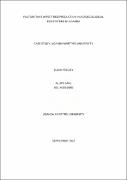| dc.description.abstract | The research study examines factors that affect rice production in 3 Agro-ecological Ecosystems in Uganda and determinants of its yield, based on data obtained from a field survey; with research design survey method, through structured questionnaire interviews for 50 farmer households per district which were chosen randomly in 3 parishes for every district and focus group discussions at Parish level with each focus group held having a representation of at least 15 members or more per district. The data from focus group survey was used as check list for farmer household structured questionnaire survey conducted in 3 out of the 10 agro-ecological zones of Uganda. Three districts were (Kumi, Hoima and Lira) which fall in the Kyoga Basin/plains (KB); Western Savannah Grasslands (WSG) and the North Eastern Savannah Grasslands (NESG) respectively. These answers research questions: What are the rice characteristics of agro-ecosystems, factors that affect the yields of rice and the rice production constraints among rice producing households of Kumi, Hoima and Lira districts?
The UBOS Agricultural Household Survey of 2008/09 the rice yield per ha of 2.5 t for the entire farmers growing rice in the country but this is the average over 1.6 t for Western, 1.7 t for Northern, 0.8 t for Central and 3.6 t for Eastern regions (UBOS, 2011). Except Eastern region where irrigated rice cultivation dominates, the yield levels of sampled farmers in 2007/08 are comparable to or higher than those in 2008/09 reported by UBOS. The rice cultivation in Sub-Sahara Africa (SSA), agronomists and development practitioners have found that there is room to increase agricultural productivity by improving on cultivation practices (de Graft-Honson et al. 2014). Since this type of technology does not require additional expenses, can easily be accepted by small holder farmer. As shown in table 13 from the regression analysis, there were only four variables that significantly affected rice yield: (i) The level of education attended by the farmer, (ii) the type of rice variety grown, (ii) whether or not a farmer belonged to a farmer group and (iv) Farmer constraints in rice production mainly insect pests, financial, diseases and chemical inputs. The level of education of household heads, contact with extension, training, ease of access to rice seed and membership to farmer groups are the factors that positively influenced the willingness to adopt rice new technologies. In conclusion, the major constraints to rice production were mainly linked to lack of adequate sensitization and training of farmers on proper methods of farming. The starter material (seed) is the most important factor for crop production; farmers still r0elied on local seed, whose quality is questionable. Hence, there is need to strengthen extension services to ensure that improved technologies generated through research achieve rice farmer yield benefits | en_US |


